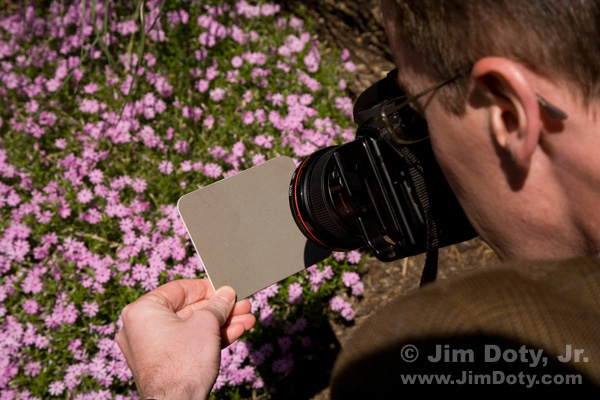Can You Use a Grey Card to Get a Proper Reading From a Far Away Subject
Home > Learn > Why Is Metering So Important? > Using An 18% Greyness Carte du jour
Incident Light Metering on the Cheap:
How to Use an 18% Gray Carte
Jim Doty, Jr.

The Gray Menu Advantage
Y'all can have many of the advantages of a $300 - $400 incident light meter for less than $twenty. Sound likewise practiced to exist true? It isn't. This is about as close as you can get to a photographic "free lunch".
When I first got serious about metering (one of the first signs a photographer is getting serious nearly the quality of their work), I wanted an incident light meter simply I couldn't beget ane all the same. Then I did the next best affair at the time, I bought an 18% gray card. It was an fantabulous conclusion. I highly recommend yous get a gray card if you don't have one yet.
18% gray cards are manufactured to exacting standards (or at least the good ones are). They are neutral in tone and reflect xviii% of the low-cal that falls on them. This gives you lot a known standard of reference. 18% is pretty shut to the reflectivity standards to which most camera meters are calibrated.
The challenge with reflected light meters (the kind that'south inside your camera) is making allowances for subject tonality. Every subject that is lighter or darker than a medium tone (i.e., lighter or darker than a gray card), requires some exposure bounty, and most photographic subjects are lighter or darker than a medium tone. Exposure bounty means y'all have to vary from what your photographic camera meter tells you if you want the best possible exposure. More about that here . If you are using your camera'southward built in meter, you have to vary from what that meter tells you lot about of the time.
Using an eighteen% Gray Card
For nigh subjects, a gray carte du jour makes that much simpler. Meter a gray bill of fare in the same light that is falling on your subject, lock in that meter reading, put away your gray card and photograph your subject. It is as unproblematic as that, and it works for all only the lightest and darkest subjects. Information technology is similar incident light metering on the cheap.
Technically, you aren't actually doing incident light metering when you meter a gray bill of fare, you are using the reflected light meter in your camera. But when y'all meter a gray card, the meter reading should be the same every bit the one y'all would get if you pointed an expensive incident lite meter at the light source (and for a small fraction of the toll). With a gray carte, you are metering a subject with a set tonality (18% reflectance), making metering easier.
There are a few things to keep in mind (in that location always are when it comes to any aspect of photography).
- The gray card needs to be in the aforementioned light as the light falling on your field of study.
- Hold the gray menu close enough to the camera so the meter only sees the gray card, but don't cast a shadow on the greyness card. In the photo at the height of this page, the lens is casting a shadow on the corner of the gray menu, but the camera is set to partial area metering and so the meter just sees the sunlit function of the gray menu.
- Focus on your subject, then turn autofocus off, meter the gray card, and then photograph the subject. Don't focus on the gray card, considering changing the focus of the lens tin can alter the exposure with some lenses (see the close-up section below for more than info).
- When your gray card develops a shine or sheen on the surface, throw it away and get a new i. As the surface of a gray gets worn and shiny with use, information technology no longer provides an accurate meter reading.
Exposure Bounty
For medium toned, light toned, and dark toned subjects, no exposure compensation is necessary, at least theoretically. That'southward the proficient news. For very light and very dark toned subjects, some exposure compensation is necessary. Follow the same exposure compensation suggestions y'all would use if you were using an incident light meter .
Decrease about 1/ii of light from what the gray menu meter reading tells you for bright white subjects (like sunlit snow). Cheque the histogram. If you lot accept burned out pixels, subtract a full stop (-ane) from your gray card reading and take the moving-picture show again.
Add about a cease of light to what the grayness card meter reading tells you for very dark toned subjects (like a gorilla or a black locomotive).
Where to "Indicate" the Gray Card
But like using an incident light meter, the direction you lot "betoken" the surface of the grayness card is of import, fifty-fifty more than important than with an incident low-cal meter. In most situations, you will want to take the gray bill of fare facing the most important calorie-free source. If you are doing photos of sidelit subjects, the lord's day should be behind your dorsum and the gray menu should be facing the sunday as you meter it'south surface. Once you lock in the meter reading, turn and face your sidelit subject and accept the moving-picture show. The sunlit side of your subject will be properly exposed, the shady side will be underexposed.

In this sidelit photo of Denali I turned my back to the sun so the gray side of my greyness card was facing the sunlight. I metered the surface of the gray card and locked in that exposure. And then I turned to face Denali and took the moving-picture show. The sunlit side of Denali is properly exposed and the shady side is underexposed, merely like it looked in real life.
If you are in a situation where you desire to base the exposure on the shady side of your subject, then you should face the sun and the gray carte volition be facing away from the lord's day every bit you lot meter the gray surface. The shady side of your subject area will exist properly exposed and the sunlit side will be overexposed.
The same is true of backlit subjects. Face the sun and the gray bill of fare will be facing away from the dominicus as y'all meter the greyness surface.

This girl is backlit by the sun. The right style to apply a gray card in this situation is to face up the sun and meter the surface of the grey card as it is facing away from the sun. Lock in that meter reading (so the camera meter isn't fooled by the brilliant sunlit grass) and take the picture.
Using a Gray Carte to Learn Field of study Tonality
A gray card is a keen way to larn all virtually subject field tonality. Put your camera in discontinuity priority way and set the f-stop to f/8. Meter the gray carte and and so meter your subject and compare shutter speeds. You will shortly learn how much lighter or darker your bailiwick is from a medium greyness. Mastering bailiwick tonality is a big step toward condign a better photographer.
Some tonality examples: If the grey card metering reading (at f/8) is ane/500 and the meter reading of snow in the same lite (at f/eight) is i/2000, you know that the snow is 2 stops lighter than a medium tone (faster shutter speeds mean lighter subjects). If the gray carte du jour reading is ane/60 and the meter reading of a sandy beach in the same light is ane/125, the sand is one stop lighter than a medium tone. If the gray menu reading is one/90 and the meter reading for some orange flowers in the same light is 1/60, the orange flowers are 1/2 end darker than a medium tone (longer shutter speeds mean darker subjects).
The more you practice, the better you lot will get. When y'all tin can predict how much lighter or darker a subject is than a medium tone with about ane/2 stop of accuracy, you lot tin can retire your grayness carte!
Setting Your Camera's Custom White Balance with A Gray Card
Because a grey card is manufactured to be neutral in tone, a grayness bill of fare is one of the all-time ways to set the "custom white balance" on your camera. (Some cameras don't let you to set a custom white remainder so check the transmission to see if you accept this excellent feature.) Meter the greyness card in the same lite as your subject field and take a picture show of it. The photograph doesn't need to be in focus but it does need to fill the frame and then nix shows but the gray card. Using the instructions in your camera'southward manual (every camera does this a little differently), employ the photo of the gray menu to set the custom white balance. Be sure and change the white balance on your camera'due south dial or card to "Custom White Balance". In one case the white balance has been set, meter the gray menu again (changing the white balance can modify the exposure). Now you are ready to take pictures. If the colour of the light changes, you will demand to set the white balance again. If the intensity of the light changes, reset the custom white balance equally well as the exposure.

Pinkish Ladyslipper Orchid
Doing Close-ups with a Greyness Card
In the orchid photo above, the dark green leaves in the background would throw off a camera meter and the orchid would be overexposed. Information technology is a perfect situation for using a gray bill of fare. With my photographic camera on a tripod and my lens focused on the orchid, I turned off autofocus and put a greyness carte in between the orchid and my lens. With the gray carte du jour angled slightly upwardly to take hold of the light from the gray heaven (the master light source), I metered the gray card and locked in the exposure reading. And so I moved the gray card out of the fashion and photographed the orchid.
Information technology is important to turn off autofocus before using a grayness card. Every bit many lenses focus closer, they become longer, the light gets darker and the exposure changes. The lens, in essence, becomes a tunnel and the longer the tunnel, the darker information technology gets. Some lenses (especially macro lenses) will lose one or two stops of light as they arroyo the point of closest focus. If yous focus on the gray carte du jour, the lens gets longer and the exposure changes. Remember to focus on the subject, turn off autofocus, meter the gray carte in the same light equally the bailiwick, lock in the exposure, then take the picture.
A Gray Card VS An Incident Light Meter
A gray card is easier to acquit than an incident light meter, it has no breakable moving parts or fragile electronics, it doesn't demand a battery, and information technology costs a small fraction of the price of an incident light meter. A gray bill of fare is the simplest way to learn about subject area tonality, and you tin use it to set a very accurate white balance on a digital camera (something an incident light meter can't exercise).
So why own an incident light meter? Ii very good reasons. (ane) If your camera meter dies, you lot can use an incident light meter as a fill-in meter. (2) An incident low-cal meter is less directionally sensitive than a gray card. Information technology matters in general where you betoken the white dome of an incident light meter (toward the light source, away from the light source or somewhere in between) but the verbal bending doesn't matter that much due to the round light gathering dome. Only the angle of a gray card is far more directionally sensitive and it is important that the angle is much closer to the right direction than is true with an incident calorie-free meter. (3) Most incident light meters have a built in wink meter. Grayness cards can't directly mensurate flash output. (You tin crook and photograph a grey card with a flash unit and cheque the histogram on the back of a digital camera, but that is a whole other topic.)
If you have both, which practise yous carry with you? Either or both. It depends on how light you are traveling and whether or not yous need to take a fill-in meter. If y'all are using transmission flash, the incident light meter is the best way to go.
The Grayness Card Versus Photographic camera Meter Reflectivity Difference
Supposedly, photographic camera meter reflectivity is shut enough to the xviii% gray carte standard as to not brand much of a difference. But many camera meters are calibrated much closer to a 12% reflectance standard, or nearly a 1/ii cease difference from a gray carte. To be technically accurate when using a gray bill of fare, you lot would add 1/2 stop of light to every meter reading y'all get when using a grayness bill of fare. Practically speaking, you may not need to do that. If you utilise an 18% gray carte on a regular basis and find your images are consistently a little nighttime, add one half cease of exposure compensation (+1/2) to your grey card meter readings. If yous use a gray card and your images look just fine, there is no need for you to practise the +one/two compensation.
Recommendations: Buying a Gray Card You tin notice an 18% gray card at your local camera shop, or social club a pair at my photography store for betwixt $12 and $twenty. They come in an 8x10 inch size and you lot can cut them in half to you take four that are 5x8 inches, a handy size. when 1 wears out you throw it away and go along to the side by side. Don't get a gray card that is smaller than 5x7 or information technology will be too modest to make full the frame without getting too shut with your photographic camera lens. Go a grey menu this is white on the back, or white with black print. My first selection is the Kodak brand just others are available, Delta being a practiced alternate option. You can as well get a collapsible, material gray card for around $30. You can find all of these in the Photograph Goodies section of my photography shop .
Exposure Articles
Why Is Exposure Then Of import?
Speaking Your Camera's Exposure Language: Aperture, Shutter Speed, and ISO
Using Reflected Low-cal Meters, Office I
Using Reflected Light Meters, Role Ii
Simplify Your Life with an Incident Light Meter
Turn Your Camera Meter Into An Incident Light Meter: Using an ExpoDisc
Using a Gray Carte du jour, Incident Light Metering on the Cheap
The RAW versus Jpeg Exposure Advantage
More Information
The nearly detailed data about using incident light meters, gray cards, and camera meters is in my book, Digital Photography Exposure for Dummies .
February 17, 2011
Updated October. 1, 2013
Source: https://jimdoty.com/learn/exp101/exp_gray_card/exp_gray_card.html
0 Response to "Can You Use a Grey Card to Get a Proper Reading From a Far Away Subject"
Post a Comment